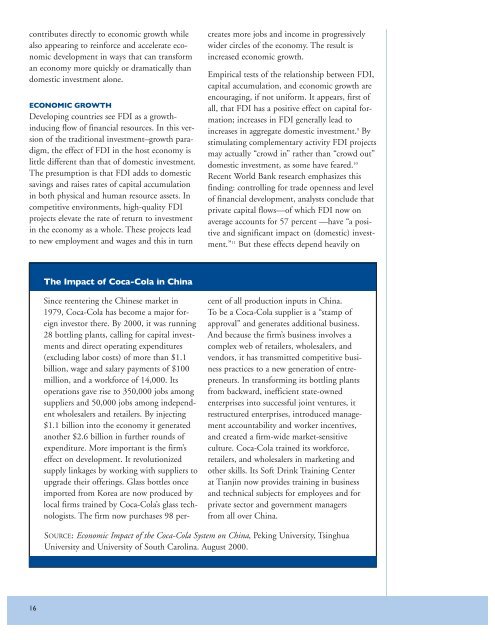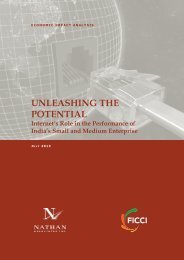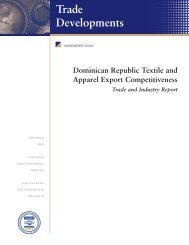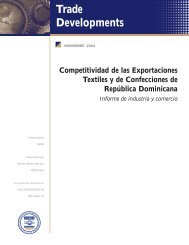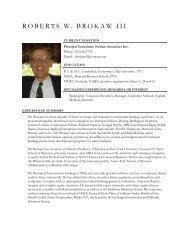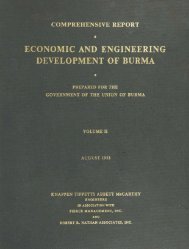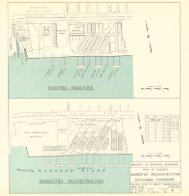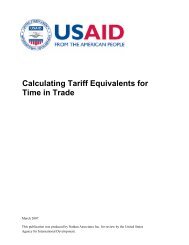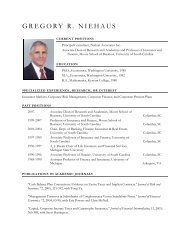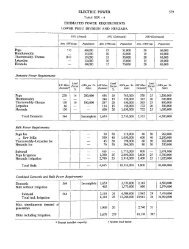Putting it to Work in Developing Countries - Nathan Associates
Putting it to Work in Developing Countries - Nathan Associates
Putting it to Work in Developing Countries - Nathan Associates
You also want an ePaper? Increase the reach of your titles
YUMPU automatically turns print PDFs into web optimized ePapers that Google loves.
contributes directly <strong>to</strong> economic growth while<br />
also appear<strong>in</strong>g <strong>to</strong> re<strong>in</strong>force and accelerate economic<br />
development <strong>in</strong> ways that can transform<br />
an economy more quickly or dramatically than<br />
domestic <strong>in</strong>vestment alone.<br />
ECONOMIC GROWTH<br />
Develop<strong>in</strong>g countries see FDI as a growth<strong>in</strong>duc<strong>in</strong>g<br />
flow of f<strong>in</strong>ancial resources. In this version<br />
of the trad<strong>it</strong>ional <strong>in</strong>vestment–growth paradigm,<br />
the effect of FDI <strong>in</strong> the host economy is<br />
l<strong>it</strong>tle different than that of domestic <strong>in</strong>vestment.<br />
The presumption is that FDI adds <strong>to</strong> domestic<br />
sav<strong>in</strong>gs and raises rates of cap<strong>it</strong>al accumulation<br />
<strong>in</strong> both physical and human resource assets. In<br />
compet<strong>it</strong>ive environments, high-qual<strong>it</strong>y FDI<br />
projects elevate the rate of return <strong>to</strong> <strong>in</strong>vestment<br />
<strong>in</strong> the economy as a whole. These projects lead<br />
<strong>to</strong> new employment and wages and this <strong>in</strong> turn<br />
creates more jobs and <strong>in</strong>come <strong>in</strong> progressively<br />
wider circles of the economy. The result is<br />
<strong>in</strong>creased economic growth.<br />
Empirical tests of the relationship between FDI,<br />
cap<strong>it</strong>al accumulation, and economic growth are<br />
encourag<strong>in</strong>g, if not uniform. It appears, first of<br />
all, that FDI has a pos<strong>it</strong>ive effect on cap<strong>it</strong>al formation;<br />
<strong>in</strong>creases <strong>in</strong> FDI generally lead <strong>to</strong><br />
<strong>in</strong>creases <strong>in</strong> aggregate domestic <strong>in</strong>vestment. 9 By<br />
stimulat<strong>in</strong>g complementary activ<strong>it</strong>y FDI projects<br />
may actually “crowd <strong>in</strong>” rather than “crowd out”<br />
domestic <strong>in</strong>vestment, as some have feared. 10<br />
Recent World Bank research emphasizes this<br />
f<strong>in</strong>d<strong>in</strong>g: controll<strong>in</strong>g for trade openness and level<br />
of f<strong>in</strong>ancial development, analysts conclude that<br />
private cap<strong>it</strong>al flows—of which FDI now on<br />
average accounts for 57 percent —have “a pos<strong>it</strong>ive<br />
and significant impact on (domestic) <strong>in</strong>vestment.”<br />
11 But these effects depend heavily on<br />
The Impact of Coca-Cola <strong>in</strong> Ch<strong>in</strong>a<br />
S<strong>in</strong>ce reenter<strong>in</strong>g the Ch<strong>in</strong>ese market <strong>in</strong> cent of all production <strong>in</strong>puts <strong>in</strong> Ch<strong>in</strong>a.<br />
1979, Coca-Cola has become a major for- To be a Coca-Cola supplier is a “stamp of<br />
eign <strong>in</strong>ves<strong>to</strong>r there. By 2000, <strong>it</strong> was runn<strong>in</strong>g approval” and generates add<strong>it</strong>ional bus<strong>in</strong>ess.<br />
28 bottl<strong>in</strong>g plants, call<strong>in</strong>g for cap<strong>it</strong>al <strong>in</strong>vest- And because the firm’s bus<strong>in</strong>ess <strong>in</strong>volves a<br />
ments and direct operat<strong>in</strong>g expend<strong>it</strong>ures complex web of retailers, wholesalers, and<br />
(exclud<strong>in</strong>g labor costs) of more than $1.1 vendors, <strong>it</strong> has transm<strong>it</strong>ted compet<strong>it</strong>ive busibillion,<br />
wage and salary payments of $100 ness practices <strong>to</strong> a new generation of entremillion,<br />
and a workforce of 14,000. Its preneurs. In transform<strong>in</strong>g <strong>it</strong>s bottl<strong>in</strong>g plants<br />
operations gave rise <strong>to</strong> 350,000 jobs among from backward, <strong>in</strong>efficient state-owned<br />
suppliers and 50,000 jobs among <strong>in</strong>depend- enterprises <strong>in</strong><strong>to</strong> successful jo<strong>in</strong>t ventures, <strong>it</strong><br />
ent wholesalers and retailers. By <strong>in</strong>ject<strong>in</strong>g restructured enterprises, <strong>in</strong>troduced manage<br />
$1.1 billion <strong>in</strong><strong>to</strong> the economy <strong>it</strong> generated ment accountabil<strong>it</strong>y and worker <strong>in</strong>centives,<br />
another $2.6 billion <strong>in</strong> further rounds of and created a firm-wide market-sens<strong>it</strong>ive<br />
expend<strong>it</strong>ure. More important is the firm’s culture. Coca-Cola tra<strong>in</strong>ed <strong>it</strong>s workforce,<br />
effect on development. It revolutionized retailers, and wholesalers <strong>in</strong> market<strong>in</strong>g and<br />
supply l<strong>in</strong>kages by work<strong>in</strong>g w<strong>it</strong>h suppliers <strong>to</strong> other skills. Its Soft Dr<strong>in</strong>k Tra<strong>in</strong><strong>in</strong>g Center<br />
upgrade their offer<strong>in</strong>gs. Glass bottles once at Tianj<strong>in</strong> now provides tra<strong>in</strong><strong>in</strong>g <strong>in</strong> bus<strong>in</strong>ess<br />
imported from Korea are now produced by and technical subjects for employees and for<br />
local firms tra<strong>in</strong>ed by Coca-Cola’s glass tech- private sec<strong>to</strong>r and government managers<br />
nologists. The firm now purchases 98 per- from all over Ch<strong>in</strong>a.<br />
SOURCE: Economic Impact of the Coca-Cola System on Ch<strong>in</strong>a, Pek<strong>in</strong>g Univers<strong>it</strong>y, Ts<strong>in</strong>ghua<br />
Univers<strong>it</strong>y and Univers<strong>it</strong>y of South Carol<strong>in</strong>a. August 2000.<br />
16


